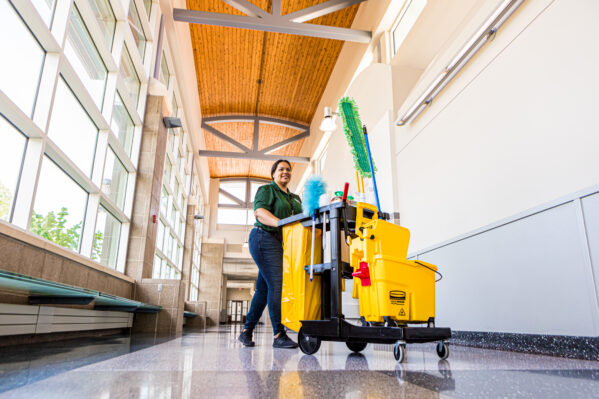Mastering Housekeeping in the Workplace: Planning, Practices and Safety

Before cleaning specialists and their teams start their work, they need to ensure their workspace is clean and safe. It’s not just about tidying up—it’s about planning ahead. From deciding who handles the trash to organizing where supplies are stored, good housekeeping requires thinking ahead to keep everyone safe. This proactive approach makes cleaning smoother and more efficient.
Planning Responsibility for Debris Removal
Before starting any cleaning or maintenance tasks, it’s important to choose who will take care of removing debris. This means deciding who handles different types of waste like regular trash, recyclables, dangerous materials or construction leftovers.
Planning Material/Supplies Storage
It’s important to store materials and supplies properly to keep the workplace safe and tidy. This means figuring out where to put different things and how to organize them. When planning storage, you need to think about easy access, safety and making sure everything stays in good condition. Setting up a system to label, track and restock supplies can make things run smoothly and stop you from running out or having too much of something.
Read More: Staying Safe on the Job
Housekeeping is Influenced by Two Things
- Human Actions or Neglect
The effectiveness of housekeeping practices is heavily influenced by the actions (or lack thereof) of individuals within a space. Neglecting basic cleaning tasks, failing to follow established procedures or disregarding safety guidelines can lead to hazardous conditions and increased risks of accidents or injuries.
Regular training can help reinforce the importance of good housekeeping habits and promote a culture of cleanliness and safety among employees.
- Weather Conditions
Weather can have a significant impact on housekeeping efforts, especially in outdoor or semi-enclosed environments. Factors such as rain, snow, wind and temperature fluctuations can create additional challenges for maintaining cleanliness and safety.
Strategies for mitigating weather-related hazards may include implementing drainage systems to prevent water accumulation, placing matting in areas with high foot traffic and adjusting cleaning schedules or procedures in response to weather forecasts.
Implementing Good Housekeeping Practices
Garbage Disposal: Ensuring that waste is promptly and properly disposed of reduces the risk of clutter and potential hazards.
Material and Supply Security: Securing materials and supplies prevents accidents caused by shifting or rolling objects and maintains an organized work environment.
Janitorial Cart and Closet Maintenance: Keeping janitorial carts and closets clean and orderly enhances efficiency and accessibility when performing cleaning tasks.
Regular Cleaning: Regular sweeping and cleaning help remove dirt, debris and other potential hazards, contributing to a safer and more pleasant environment.
Read More: How FBG Prioritizes Safety Year Round
By meticulously planning and executing these aspects of good housekeeping, facilities can create safer, more efficient and more comfortable spaces for their occupants and employees.